Ways To Use Ships As A Dungeon Part 1
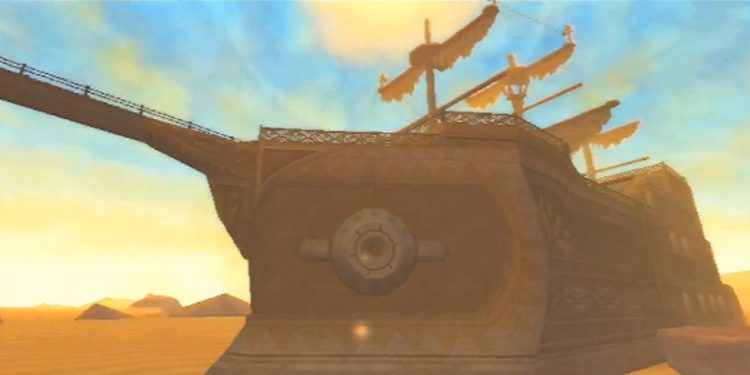
Ships as dungeons is an interesting challenge because they are mobile, limited in size, and waterborne. Expanding some definitions, however, can lead to a variety of possibilities you may not have thought of.
1. Redefine What A Ship Is
A ship doesn’t have to be this thing that floats on water. Maybe it’s an elven airship that sails through the skies or a submarine that inhabits the depths. Or perhaps it could be a dwarven ship that sails through solid stone in the Elemental plane of Earth or is the deceased hull of what used to be a dragon turtle.
Other options are to have the ship on lava or traveling within ley lines in your world’s magic system or even in space.
In cases like these, the players would be stuck on the ship until they could figure out how or where to exit
2. Examine Different Types Of Ships
There’s always the classic haunted pirate ship. But even these can be changed up by rearranging the levels and having hidden passages. Why not set a dungeon on a giant version of a Viking ship?
Or have the dungeon be an old-fashioned paddle wheel steamboat, a cargo ship, or a prison ship. If you don’t mind borrowing from modern day, consider a cruise ship or a canal ship as a location.
3. Consider Expanding The Location In Unique Ways
In Zelda: Skyward Sword, there are these items called “time stones” that shift a portion of the level back and forth through time.
Another way you could expand the location is to have the ship occupy two or more dimensions simultaneously, and the players have to shift from one to another to get to different places in the ship.
A third way to expand the location is for parts to have different gravity rules, but under different circumstances, so players never know whether or not they’ll be affected.
Finally, there could be different areas to explore, depending on the character’s size. Maybe part of the ship needs to be explored while they’re the size of an ant.
5. Consider Different Races
In designing a ship as a location, think not only of standard fantasy races but variations of them. For instance, you might have a group of Avariel (winged elves) who are sailing above the treetops, or tinker gnomes, with their penchant for all things mechanical, in some sort of steam-driven airship, and wearing magic-punk collapsible hang gliders that allow them to rain death from above.
Or you might have powrie (bloody cap dwarves) who use their heat-proof barrel boats in lava.
Also think of other intelligent races that might want to travel, but may not wish or be able to travel to a location normally. For instance, you might have dragons that have starships, beholders who sail within the ley lines, or lizardmen who explore the deep in submarines.
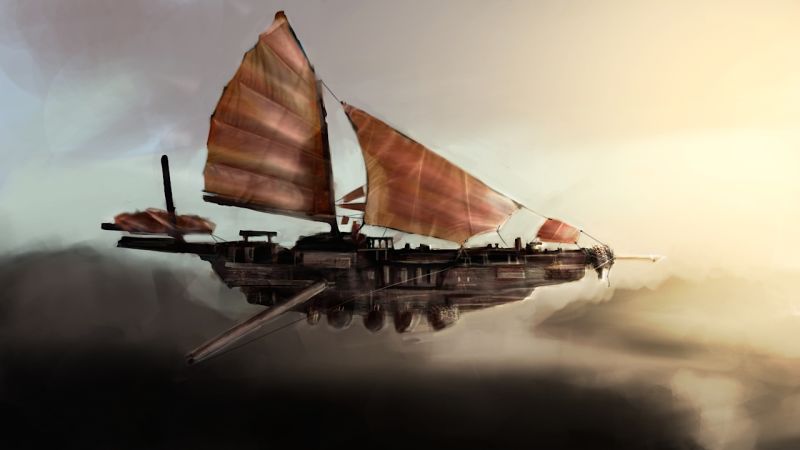
5. Consider The Reason For The Dungeon To Be There
Ask yourself “what’s the story behind why this is here?”
Stumped for answers? Consider the following ideas:
- Protection of a magical item. The dungeon moves around because it protects a magic item that, if it fell into the wrong hands, would mean the end of the world. The creatures and traps are a test of merit. Those who fail are not worthy of the ultimate treasure.
- Lost in time. In Zelda: Skyward Sword, the ship dungeon was lost to the annals of time, the area gradually became desert, and the ship fell into disrepair.
- Consider the opening sequence as narrated by James T Kirk: “Space, the final frontier. These are the voyages of the starship Enterprise. Its five-year mission: to explore strange new worlds, to seek out new life and new civilizations, to boldly go where no man has gone before.”
- A prison. Maybe everyone and everything on this ship is there to keep something inside, and others out. Maybe the traps, automated guards, etc. are the ship’s defenses to prevent the criminal’s escape.
- Creative genius. The dungeon might be a ship because the person (or people) building it simply could. They wanted to challenge others with their creativity, but also wanted to make it a challenge to even get there, so they made it.
- The result of an experiment gone bad. Similar to the prison scenario, the magic or science experiment is too dangerous to remain free in the general sense of the term, so it was put into this ship and set adrift. It could be free as in the case of the Minotaur wandering its maze, but in this case the experiment would be wandering the ship.
6. Change the circumstances on the ship
A ship that’s afire is a vastly different experience than one that is sitting in a calm sea. As can a violent storm that tosses it about. Adding hazards of smoke, rotting wood, cold, low light conditions, or radiation can totally change the character’s experience, as can being underwater, in the vacuum of space, in an active volcano, and so on
76 Types of ships (taken from Wikipedia)
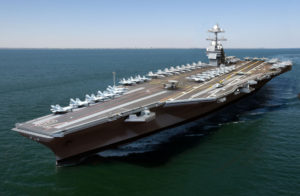 Aircraft Carrier: Naval vessel able to launch and retrieve airplanes.
Aircraft Carrier: Naval vessel able to launch and retrieve airplanes.- Barque: A sailing vessel with three or more masts, fore-and-aft rigged on only the aftermost.
- Barquentine: A sailing vessel with three or more masts, square-rigged only on the foremast.
- Battlecruiser:A lightly armoured battleship.
- Battleship: A large, heavily armoured and heavily gunned warship. A term which generally post-dates sailing warships.
- Bilander: a small European merchant ship with two masts – used in the Netherlands for coast and canal traffic and occasionally seen in the North Sea but more frequently to be seen in the Mediterranean Sea
- Bireme: An ancient vessel, propelled by two banks of oars.
- Birlinn: a wooden vessel propelled by sail and oar, used extensively in the Hebrides and West Highlands of Scotland from the Middle Ages
- Blockade runner: A ship whose current business is to slip past a blockade.
- Boita: A cargo vessel used for trade between Eastern India and Indochina.
- Brig: A two-masted, square-rigged vessel.
- Brigantine: A two-masted vessel, square-rigged on the foremast and fore-and-aft rigged on the main.
- Caravel: A much smaller, two, sometimes three-masted ship.
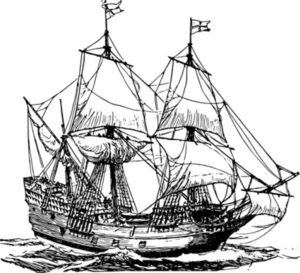 Carrack: a three- or four-masted ocean-going sailing ship and was developed in the 14th and 15th centuries in Europe. Developed from the single-masted cog, the carrack was first used for European trade from the Mediterranean to the Baltic. In its most advanced forms, it was used by the Portuguese for trade with the African coast and finally with Asia and America from the 15th century before evolving into the galleon of the 16th and 17th centuries.
Carrack: a three- or four-masted ocean-going sailing ship and was developed in the 14th and 15th centuries in Europe. Developed from the single-masted cog, the carrack was first used for European trade from the Mediterranean to the Baltic. In its most advanced forms, it was used by the Portuguese for trade with the African coast and finally with Asia and America from the 15th century before evolving into the galleon of the 16th and 17th centuries.- Cartel: A small boat used to negotiate between enemies.
- Catboat: A sailing vessel characterized by a single mast carried well forward (i.e., near the bow of the boat).
- Clipper: A fast multiple-masted sailing ship, generally used by merchants because of their speed capabilities.
- Cog: a type of ship that first appeared in the 10th century, and was widely used from around the 12th century on. Cogs were generally built of oak, which was an abundant timber in the Baltic region of Prussia
- Collier: A vessel designed for the coal trade.
- Corvette: A small, maneuverable, lightly armed warship, originally smaller than a frigate.
- Cruise Ship: A ship that is designed to bring people to different ports on a vacation
- Cruiser: A warship that is larger than a destroyer, but smaller than a battleship.
- Cutter: Several types of fast, modest-sized boats
- Destroyer: A warship mainly used for anti-submarine warfare and escort duties.
- Dreadnought: An early twentieth century type of battleship.
- Drekar: A Viking longship with sails and oars.
- Dromons: Ancient precursors to galleys.
- East Indiaman: An armed merchantman belonging to one of the East India companies (Dutch, British etc.)
- Faering: A type of Viking open rowboat
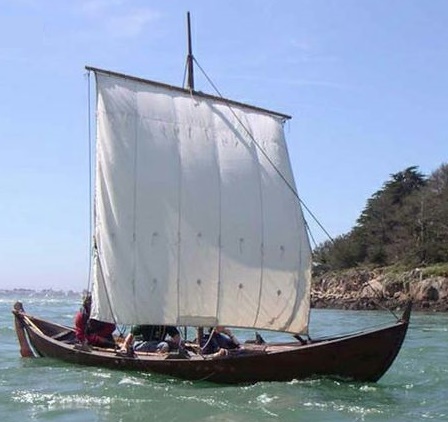
- Felucca: A traditional Arab type of sailing vessel
- Fire ship: A vessel of any sort, set on fire and sent into an anchorage with the aim of causing consternation and destruction. The idea is generally that of forcing an enemy fleet to put to sea in a confused, therefore vulnerable state. Conversely, also a ship where a funeral pyre was lit.
- Flüte: A sailing warship used as a transport, with a reduced armament
- Fluyt: A Dutch-made vessel from the Golden Age of Sail, with multiple decks and usually three square-rigged masts, usually used for merchant purposes.
- Frigate: A term used for warships of many sizes and roles over the past few centuries.
- Galleass: A sailing and rowing warship, equally well suited to sailing and rowing.
- Galleon: A sixteenth century sailing warship.
- Galley: A warship propelled by oars with a sail for use in a favourable wind.
- Galliot: several types of ships —
- Mediterranean, (16th century–17th century): a type of ship with oars, also known as a half-galley, then, from the 17th century forward, a ship with sails and oars. As used by the Barbary pirates against the Republic of Venice, a galiot had two masts and about 16 pairs of oars. Warships of the type typically carried 2 – 10 small caliber cannons, and between 50 and 150 men.
- North Sea (17th century–19th century)” a type of Dutch or German 20 to 400 GRT trade ship, similar to a ketch, with a rounded fore and aft like a fluyt. They had nearly flat bottoms to sail in shallow waters. These ships were especially favored for coastal navigation in the North Sea and Baltic Sea. To avoid excessive leeway, or leeward drift due to their flat bottoms, smaller vessels were usually fitted with leeboards. After 1830, a modernized type of galiot was developed that featured a sharper bow similar to a schooner. These vessels rarely had leeboards.
- Naval ships (17th century–19th century) a French term for a type of naval warship that might have two masts with lateen sails and a bank of oars. It might also be relatively small with only one mast, and be little more than a large chaloupe or launch.
A galiote a bombes was a French term for a galiote armed with a mortar and
functioning as a bomb vessel, i.e., a vessel armed to shell coastal forts, towns, and the
like.
- Gunboat: a naval watercraft designed for the express purpose of carrying one or more guns to bombard coastal targets, as opposed to those military craft designed for naval warfare, or for ferrying troops or supplies
- Ironclad: A wooden warship with external iron plating.
- Junk: A Chinese sailing ship
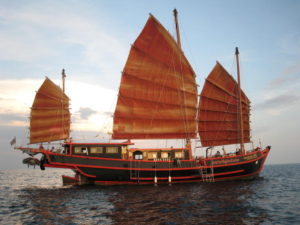
- Karve: A small type of Viking longship
- Knarr: A large type of Viking cargo ship, fit for Atlantic crossings
- Liberty ship: An American merchant ship of the late Second World War period, designed for rapid building in large numbers. (The earliest class of welded ships.)
- Longship: A Viking raiding ship
- Man-of-war: A sailing warship.
- Mistico: Small, fast two or three-masted Mediterranean sailing vessel.
- Monitor: A small, very heavily gunned warship with shallow draft. Designed for coastal operations.
- Nef: A large medieval sailing ship
- Paddle steamer: A steam-propelled, paddle-driven vessel, a name commonly applied to nineteenth century excursion steamers.
- Pantserschip: A Dutch ironclad. By the end of the nineteenth century, the name was applied to a heavy gunboat designed for colonial service.
- Penteconter: An ancient warship propelled by 50 oars, 25 on each side.
- Pink (or Pinque): One of two different types of boats.
- The first was a small, flat-bottomed ship with a narrow stern; the name derived from the Italian word pinco. It was used primarily in the Mediterranean Sea as a cargo ship.
- In the Atlantic Ocean the word pink was used to describe any small ship with a narrow stern, having derived from the Dutch word pincke. They had a large cargo capacity, and were generally square rigged. Their flat bottoms (and resulting shallow draught) made them more useful in shallow waters than some similar classes of ship. They were most often used for short-range missions in protected channels, as both merchantmen and warships.
- Pram: A small dinghy, originally of a clinker construction and called in English, as in Danish, a praam. The Danish orthography has changed so that it would now be a pråm in its original language. It has a transom at both ends, the forward one usually small and steeply raked in the traditional design.
- Pre-dreadnought: A type of battleship of the late 19th century to early 20th century, characterized by having a mixed offensive battery, in contrast to the “all-big-gun” Dreadnought type battleships.
- Q-ship: A commerce raider camouflaged as a merchant vessel.
- Quinquereme: An ancient warship propelled by three banks of oars. On the upper row three rowers hold one oar, on the middle row – two rowers, and on the lower row – one man to an oar.
- Raft: a primitive ship made of logs and often held together by rope or vines.
- Schooner: A fore and aft-rigged vessel with two or more masts of which the foremast is shorter than the main.
- Settee: Single-decked, single or double-masted Mediterranean cargo vessel carrying a settee sail.
- Shallop: A large, heavily built, sixteenth-century boat. Fore-and-aft rigged. More recently it has been a poetically frail open boat.
- Ship of the line: A sailing warship of first, second or third rate. That is, with 64 or more guns. Before the late eighteenth century, fourth rates (50-60 guns) also served in the line of battle.
- Slave ship: A cargo boat specially converted to transport slaves.
- Sloop: A fore and aft-rigged sailing vessel with a single mast.
- Small Waterplane Area Twin Hull (SWATH): A modern ship design used for Research Vessels and other purposes needing a steady ship in rough seas.
- Snow A small sailing ship, with a fore mast, a main mast and a trysail mast behind the main. Sometimes armed as a warship with two to ten guns.
- Steamship: A ship propelled by a steam engine.
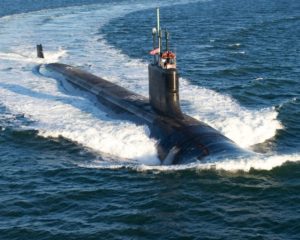 Submarine: A ship designed to travel underwater.
Submarine: A ship designed to travel underwater.- Torpedo boat: A small, fast surface vessel designed for launching torpedoes.
- Trabaccolo: A type of Mediterranean sailing coastal vessel.
- Tramp steamer: A steamer which takes on cargo when and where it can find it.
- Trireme: An ancient warship propelled by three banks of oars.
- Victory ship: a class of cargo ship
- Xebec or Zebec: a Mediterranean sailing ship that was used mostly for trading. It would have a long overhanging bowsprit and aft-set mizzen mast. The term can also refer to a small, fast vessel of the sixteenth to nineteenth centuries, used almost exclusively in the Mediterranean Sea.
- Yoal or ness yoal, traditional clinker-built Shetland rowing boat with auxiliary sail



